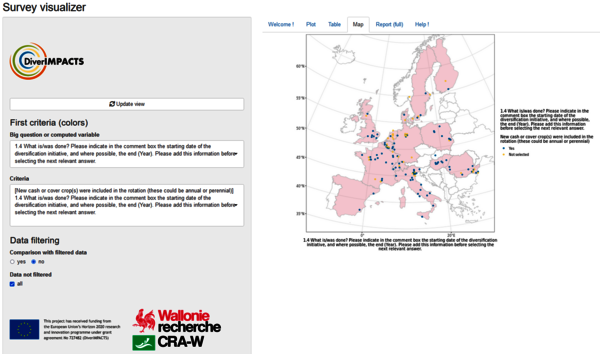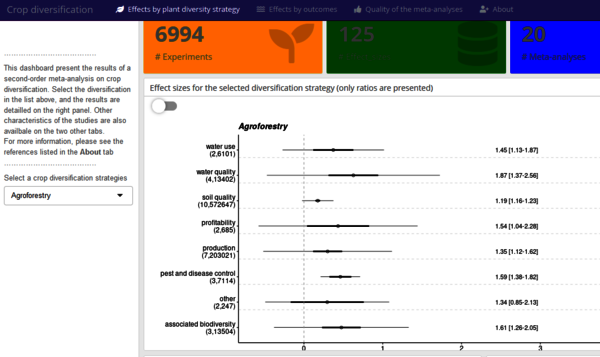Part of the DiverIMPACTS project aimed (i) to identify success and failure factors of crop diversification through a variety of experiences across Europe and (ii) to assess its benefits and drivers through a literature review. The data and the results of these analyses are now publicly available through two web-based applications.
1. Survey on previous crop diversification experiences
In order to identify success and failure factors of crop diversification, a quantitative survey of crop diversification experiences (CDEs) in Europe was conducted in 2018. 128 crop diversification experiences were collected and analysed (see link to database below). The results are now publicly available in a Shiny app (figure 1; see link below). The answers to each public survey question can be displayed in plots, in contingency tables and even on a European map. Answers to questions can be compared in pairs using a colouring feature, and answers from countries can be compared using a filtering feature. This information can support further research or debates about what has been achieved regarding crop diversification in Europe. For more information about how to use the app, please see the instruction video (link below).
2. Results of the meta-analyses based on a literature review
In order to assess the benefits and drivers of crop diversification, a large-scale literature review was conducted during the DiverIMPACTS project. The review includes a compilation of the results of 95 meta-analyses, including 5,156 studies and 54,554 experiments spanning 85 years and representing more than 120 crop species in 85 countries (link to full study below).
The results showed that these diversification practices led to a median increase of 24% in associated biodiversity—the non-cultivated biodiversity that prevails within an agroecosystem. The increase also concerned crop production (+14%), as well as the provision of several ecosystem services, such as water regulation (+51%) and soil quality (+11%) or pest and disease control (+63%).
The results of this analyses can be explored through another web-based application: ‘meta-analyses on crop diversification at the global scale’ (figure 2; see link below). This Shiny app enables users to specify the results. Users can explore which diversification strategy works best and in which context or explore the effects of diversification on the different outcomes studied. Finally, this Shiny app also presents the quality of the papers published on the subject. Project data can therefore be more easily accessed or downloaded and re-used.
Further information and links
- Zenodo.org: Database populated with European diversification experiences
- shinyapp.cra.wallonie.be: Survey visualizer app (quantitative survey on crop diversification experiences)
- Youtube.com: Tutorial the survey visualizer app
- onlinelibrary.wiley.com: Positive but variable effects of crop diversification on biodiversity and ecosystem services
- cropdiversification.shinyapps.io: Meta-analyses on crop diversification at the global scale




 tap and then scroll down to the Add to Home Screen command.
tap and then scroll down to the Add to Home Screen command.
Disqus
In order to use the comment function, you must register with the third-party provider "Disqus".
When you activate this function, your browser establishes a direct connection with the servers of the third-party provider. We would like to point out that data is transmitted to the third-party provider after activation, and the latter may set cookies that can also be used for analysis and marketing purposes. For more information, please refer to our privacy policy.
Activate